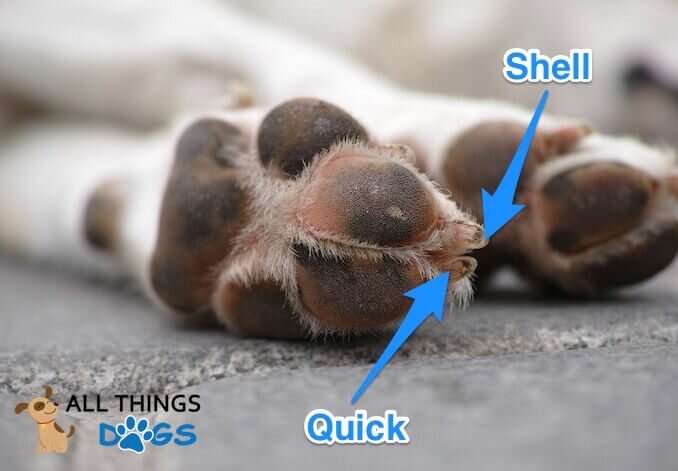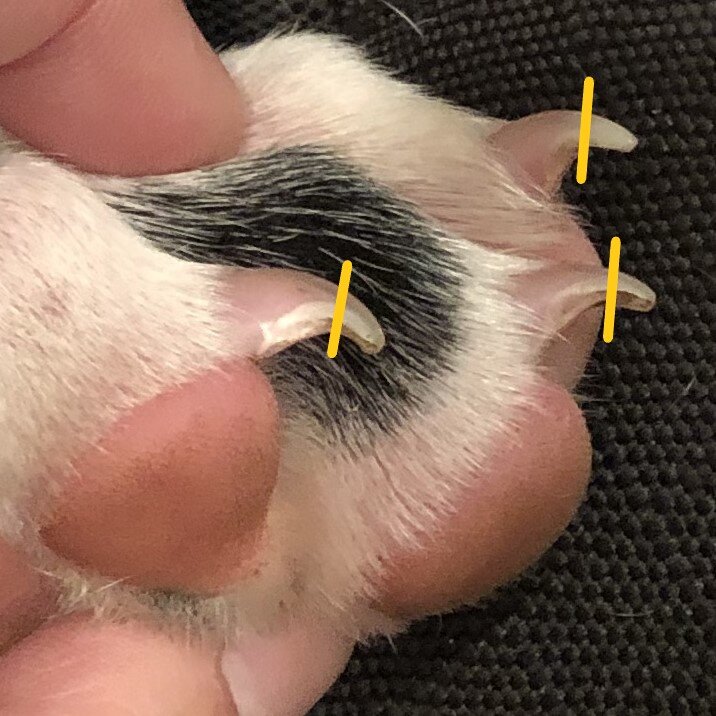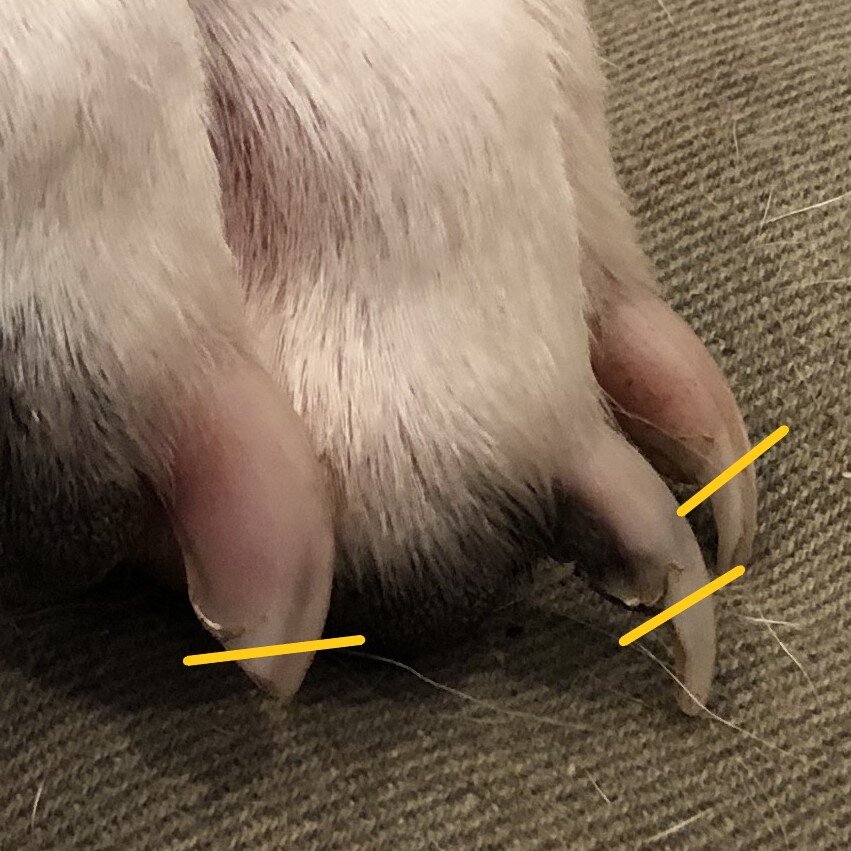Providing appropriate socialization is a critical part of raising your puppy to be a well-adjusted adult dog, one who welcomes guests into the home, walks calmly and confidently in public, and can travel with the family. It is the process of introducing your puppy to the wider world, to help prevent fear and aggression later in life. It is also the process of teaching your puppy how to behave out there, to help prevent lunging and barking and over-excitement around other dogs, skateboards, scooters, etc.
The critical socialization period begins at 3 weeks old and ends between 12 and 16 weeks old. That means that the process of safe, controlled socialization should already be started by the breeder or rescue you get your puppy from.
Wait, shouldn’t I wait to take my puppy out of the house until they have all their vaccinations done? What if my puppy gets sick?
In a word: no! A puppy who is sequestered indoors is significantly more likely to have problems with fear and aggression later in life. Here are several resources on why socialization is so important.
The American Veterinary Society of Animal Behavior's Position Statement on Puppy Socialization (PDF):
“The Primary and most important time for puppy socialization is the first three months of life. During this time puppies should be exposed to as many new people, animals, stimuli and environments as can be achieved safely and without causing over- stimulation manifested as excessive fear, withdrawal or avoidance behavior. For this reason, the American Veterinary Society of Animal Behavior believes that it should be the standard of care for puppies to receive such socialization before they are fully vaccinated.
Because the first three months are the period when sociability outweighs fear, this is the primary window of opportunity for puppies to adapt to new people, animals, and experiences. Incomplete or improper socialization during this important time can increase the risk of behavioral problems later in life including fear, avoidance, and/or aggression. Behavioral problems are the greatest threat to the owner-dog bond. In fact, behavioral problems are the number one cause of relinquishment to shelters. Behavioral issues, not infectious diseases, are the number one cause of death for dogs under three years of age.”
Puppy Vaccination and Early Socialization Should Go Together (PDF)
“Experience and epidemiologic data support the relative safety and lack of transmission of disease in these puppy socialization classes over the past 10 years in many parts of the United States. In fact; the risk of a dog dying because of infection with distemper or parvo virus disease is far less than the much higher risk of a dog dying (euthanasia) because of a behavior problem. Many veterinarians are now offering new puppy owners, puppy socialization classes in their hospitals or nearby training facilities with assistance of trainers and behaviorists. This emphasizes the importance of early socialization and training as important parts of a wellness plan for every puppy. We need to recognize that this special sensitive period for learning is the best opportunity we have to influence behavior for dogs and the most important and longest lasting part of a total wellness plan.”
2013 Study: Frequency of Parvovirus in Vaccinated Puppies that Attended Puppy Socialization Classes
“Socialization is one method of preventing behavior problems in dogs; however, some oppose socialization before 16 wk of age due to the risk of contracting infectious diseases. The objectives of this study were to determine if puppies that attended puppy socialization classes and were vaccinated by a veterinarian at least once were at an increased risk of confirmed canine parvovirus (CPV) infection compared with puppies that did not attend classes... Results indicated that vaccinated puppies attending socialization classes were at no greater risk of CPV infection than vaccinated puppies that did not attend those classes.”
Why you should take your urban puppy to socials after just one set of shots
“While not a perfect analogy, a puppy’s openness to learning socials skills is similar to the way young children learn new languages effortlessly. Studies have shown that children younger than seven years old easily pick up new languages because their brains are wired to readily incorporate the words, grammar and structure of multiple languages. Like the puppy socialization period that ends at 12 weeks, this window closes for children around seven years old, after which language acquisition becomes far more difficult. You can place a 6-year old child in a Mandarin immersion class for a year and she will come out fluent in the language but if I were to attend the same class, I would likely still be struggling with the basics.”
Early Puppy Socialization Classes: Weighing the risks vs. benefits
“Given the fact that behavior problems are the No. 1 cause of relinquishment to shelters, along with the fact that 56% of dogs that enter shelters in the United States are euthanized, and that puppy classes help prevent behavior problems and increase the likelihood of retention in the home, there must be evidence of phenomenal risk of infectious disease transmission associated with early socialization classes to warrant holding puppies back. And there is no such evidence to date. In fact, renowned behaviorist Dr. R. K. Anderson, a longtime advocate for early socialization, has more than a decade of experience and data supporting the relative safety and lack of disease transmission in puppy socialization classes in many parts of the United States.
It's unfortunate that the behavioral gains from puppy class are under such tight age constraints. The most sound advice we [veterinarians] can give clients is to acknowledge the small risk of infectious disease transmission and recommend well-run puppy socialization classes on the grounds that the relative risk is so low. Puppies, owners, and society stand to benefit enormously at the cost of a relatively small risk of exposure to a treatable infection.”
Puppy Vaccinations: Why Puppies Need a Series of Shots
“Our current vaccines are excellent at stimulating immunity in older puppies in just one or two shots. However, puppies who nursed on their mother’s milk have maternal antibodies in their blood that block the immune system from responding to these vaccines. These circulating maternal antibodies protect them from bacterial and viral assault while the puppy’s immune system is maturing. But they also prevent the puppy’s immune system from becoming activated by vaccines.”
Okay, I’m sold. Now how do I do it?
I recommend starting with these articles written by other trainers:
Puppy Socialization… What Actually Is It??
“The definition I like for puppy socialization is “the process of teaching a puppy to live and behave in the situations it will encounter throughout its life.”... All in all, socialization is a very personal process. You are not just shaping your dog to live in the human world, you are shaping him to live in YOUR world. It’s important to me that my dogs are confident and comfortable in sport situations as I do have many competition goals for them, but I live with them too so it’s equally (or more, sometimes) important that they can settle in the house, be polite on a hiking trail, and work as demo or decoy dogs for my clients. What are your goals for your dog, and what type of dog do you want to build?”
Socialization is More Than Mere Exposure - AVSAB
“You should set up social experiences in graded steps that reflect your puppy’s personality and behavior. If you notice that your puppy seems timid or fearful in new situations, you should move more slowly and deliberately in terms of the intensity of exposure than you would if your puppy is always jolly and exuberant. Pay attention to your puppy’s approach versus retreat behavior and other body language indicators.”
Overzealous Greetings (and Other Tales of Toddlers and Puppies)
“responsible dog owners can teach their charges to be polite around other dogs. Socializing your dog appropriately helps him grow into a model citizen of canine society.
So, how do I guide my foster dogs through appropriate interactions? First of all, I focus on teaching them to greet other dogs calmly. If puppies squeal and lunge in excitement every time they see a new dog, they grow into adult dogs who rush up to other dogs or react explosively on leash at the sight of each new dog. This isn’t a healthy social reaction, and preventing this behavior from developing is much easier and faster than fixing it once it’s become a habit.”
Having Trouble Walking Your Puppy? Try Less Skinner and More Darwin.
“I think it’s helpful for puppy owners to understand that the “walk” part of the walk is really more for you than the puppy. What the puppy needs to do is sniff and explore. Stop and go as he pleases. Sometimes just stand there and smell the air…
Here is a video of a walk I took with my 16-week-old puppy. You can see I’m following him for the most part. When I really need him to move along, he has the skills to do that for a few steps. This is a reasonable goal for a “walk” with a puppy this age.”
Keeping, Raising and Showing Littermates
“One should only keep multiple puppies if they truly have the time to give each puppy what they need in terms of training, medical care, socialization, grooming, etc. If you can’t or if you aren’t sure if you can, you should probably not take on more than one. If you do decide to keep multiple puppies, here are some things to consider and tips that may help you bring them up successfully.”
I also like this PDF from Operation Socialization and this graphic by Sara Reusche and Lili Chin.
If you enjoy listening to podcasts, check out The Bitey End of the Dog: “Puppies! Puppies! Puppies! A Deep Dive into Socialization and Building Resiliency with Kathy Callahan.” Links on Apple Podcasts, Spotify, Overcast or browser.
Need a cheat sheet? Here are the bullet points.
Invite people over to your house to play with the pup. Make sure that they wash their hands and haven’t just been petting unknown dogs.
Take your puppy over to visit other people’s houses. Make sure to bring supplies to clean up potty accidents, just in case.
Take your puppy out and about in a sling, pack, stroller, or just carrying them to keep them up off the ground. Walk around the neighborhood, shopping areas, and into pet-friendly stores.
Most home improvement stores (eg Home Depot, Lowe’s, Ace) welcome dogs. JoAnn is officially pet-friendly in all their locations. Many other stores will allow you to carry in small puppies if you ask.
Bring your pup on errands in the car. While one person takes care of business, the other can sit with the pup and look out the window, or have the puppy in your lap with the car door open. (See information about puppy carsickness here.)
Hang out at the park or beach with your pup on a large blanket, using a leash or pen to keep them close by.
If you want your puppy to be comfortable with particular activities when they’re grown up, starting introducing those things now. For example, start teaching your puppy to swim, or introduce him to livestock, or get started on grooming training.
Arrange play dates with other friendly, healthy, vaccinated dogs who haven’t recently been to the dog park.
Attend puppy classes - see below for how to pick a good puppy class.
Make sure that anyone interacting with your puppy - especially kids - pets gently, plays appropriately, and allows the puppy to move away if they want to. (See resources for kids and dogs here.)
Make sure that your puppy is having a good time. Things to look for:
Wagging tail
Happy to explore and sniff around
Willingness to play and eat treats
Able to respond to trained cues
If your puppy gets overwhelmed (hiding, tucked tail, sitting very still and not engaging), let him retreat to safety and reassure him. Give him time to recover and be ready to explore again.
If your puppy is regressing in their socialization, or showing sudden fear toward specific things, they may be in a fear period. Follow the suggestions in this article or consult with a professional trainer who uses positive methods to help you provide desensitization and counter-conditioning.
How to pick a puppy class
Not all training classes are created equal. You want to make sure that:
The facility is cleaned with appropriate products (such as KennelSol) to reduce possible transmission of pathogens.
Puppies are required to be up to date on vaccinations per their veterinarian’s advice, and proof is provided to the trainer.
Only positive training methods are used. (E.g., no collar corrections on choke chains or prong collars, no swatting puppies for mouthing, no grabbing by the scruff or pinning down to punish. Instead, puppies are guided to choose desirable behaviors and rewarded with treats, play, and petting, while undesirable behaviors are prevented or redirected.)
Puppies that are over-excited - barking, pouncing, pulling on leash - are given help to calm down via decreasing visibility, moving them farther away, providing chews or enrichment items, and/or rewarding appropriate behaviors.
Playtime is not a “free for all” between all of the puppies. Not all pups can play together nicely - different sizes and levels of energy and confidence can easily lead to bullying if not carefully monitored. Pens and leashes are used to help shier and smaller puppies have a good socialization experience.
Breaks are given during playtime to help moderate arousal levels and help puppies learn to listen around distractions.
All of the puppy owners are helping teach manners by giving attention to puppies with “four on the floor,” not allowing them to snatch treats, and breaking up play as needed to redirect inappropriate behavior or provide breaks.























